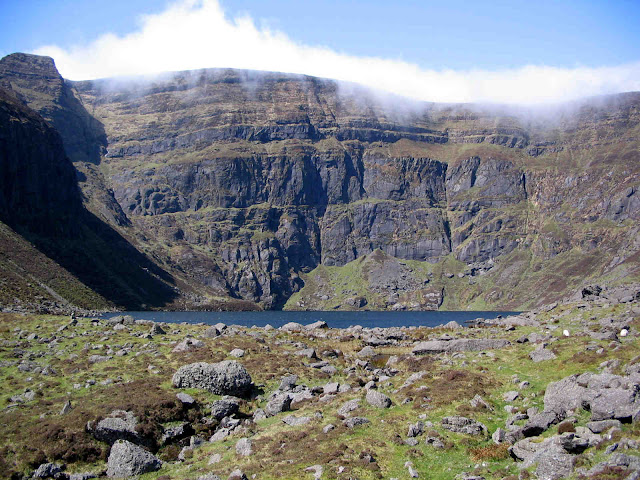 |
| Knockanaffrin (Hill of the Mass) and An Bearna (The Gap) from the Nire |
Comeragh Place Names Part 2
Now to the Root Words
Physical Features: Let`s start with the Celts` liking for naming places after physical features. Probably the most common root word on the Comeraghs is “com” which means marshy hollow. Since there are at least 14 large marshy hollows on the mountains scoured out by glaciers, it`s not surprising to see the name “Comeraghs”, which means marshy hollows, applied to the place. Coum Knockaun means the hollow of the hillock, Coumduala the hollow of the black cliff, The Sgilloges the hollow of the skillet, the Comalochas the hollow of the lakes.
 |
| Coumfea from Com Fia (Deer Hollow) or from Com Fiáin (Wild Hollow)? |
Animals and birds were also popular for naming places. Carrigshanean means the rock of the old birds, Coumfea, perhaps the hollow of the deer, Coumnagappul near Colligan the hollow of the horses, Davbeg near Kilrossanty the small ox or stag and Glenary near Clonmel possibly means the valley of the animal herder or shepherd (aoire). The word “Nire” possibly comes from the old Irish word for cow (Uidhir). Coumshingaun may mean the hollow of the ants.
Vegetation root words include “Móin” meaning turf, “Coll” meaning hazel, “Aiteann” meaning furze, “Seascann” meaning sedge, “Coill” meaning wood and “Fraochán” meaning whortleberry. You find Monavullaghs (the turf on the summit), Colligan (the hollow of the hazel), Coolattin (the recess of the furze), Curraghteskin (the sedgy marsh) and Kilfrehan (the wood of the hurts).
The early Irish were a superstitious lot, hence the appearance of names relating to fairies and mythical characters. Carraigsheegowna may mean the rock of the fairy calves (or perhaps the rock-seat of the calves!), Knockalisheen may mean the hill of the small fairy fort, Shanballyanne may refer to “Áine”, a Celtic Goddess, while Seefin means Fionn McCool`s seat.
There are some root words relating to settlement,
some of them going back a long way. “Rath”, as in Rathgormack (Cormac`s fort),
was an earthen ring fort from the early Christian period. “Graig”, as in
Graigavalla (the village on the route) near Rathgormack, was a name used for a
village often associated with early monasteries. Graig of course may also mean
rock. There is no evidence of a possible settlement here today. The townland name may refer to the large rock at the bottom of the Gap funeral route on the Rathgormack side. “Buaile” is a
very interesting root word. It was used in pre-Viking times to mean a summer herding
or milking place e.g. Boolabrien in the Nire and the Boolas near Rathgormack.
Leave out the “u” and you have “baile” which came to mean homestead and eventually
town e.g. Ballymacarbry, and Ballintslea on the Mauma road.
 |
| Com Mahon and Knockaunapeebra (both names connected to people) |
Remoteness = Few Invaders = Preservation of the Names
The Comeraghs has always been a remote barren place and this has greatly helped to preserve the old names. Still, there are some place names connected with people. The O`Briens from Thomond got land around Kilrossanty in the 15th century. As a result, you have Lemybrien and Mahon Falls (Mahon or “Mathún” in Irish was a common first name amongst the O`Briens). Crotty`s lake is named after the 18th century robber William Crotty. Knockaunapeebra above Coum Mahon means piper`s hillock.There is little evidence of recent invaders influencing place names (Viking, Norman, English planter). In the Nire you have Curtiswood and Russelstown while in Kilrossanty you had Roxboro and Newtown Palliser. The influence of the Penal Laws is seen in the name Knockanaffrin (Hill of the Mass). One interesting name in this regard is “An Staighre” used on two of the old funeral routes across the mountains. This, we assume, means stairs and comes from Irish, but interestingly the name is very similar to “stegr” from old Norse, which meant rocky path!



Comments
Post a Comment